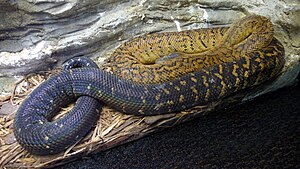Jamaican boa
| Jamaican boa | ||||||||||||
|---|---|---|---|---|---|---|---|---|---|---|---|---|

Jamaican boa ( Chilabothrus subflavus ) |
||||||||||||
| Systematics | ||||||||||||
|
||||||||||||
| Scientific name | ||||||||||||
| Chilabothrus subflavus | ||||||||||||
| ( Stejneger , 1901) |
The Jamaica boa ( Chilabothrus subflavus , Syn . : Epicrates subflavus ), in English. also Yellow snake or yellow Boa called, is a non-toxic snake of the genus Chilabothrus within the family of Boas (boidae). No subspecies are distinguished.
features
The Jamaican boa reaches a length of 1.5 to 2.3 m. The scales on the front part of their body are olive to yellow with black edges. The black portion increases towards the end of the body, forms wide black bands in the middle of the body and finally turns into a complete, iridescent black at the end of the body and tail.
Stejneger counted 39 to 45 scales and 274 to 286 ventral scales (abdominal scales) around the body . According to its first description, there is a single forehead shield between the ocular shields . The forehead shields broadly touch the preoculars . There are no labial pits . He described the coloring as pale yellow with many dorsal and lateral zigzag transverse bands which are rather interrupted and indistinct on the front body, clearly drawn and expanded towards the rear body, so that the impression of a blackish basic color arises.
Occurrence
The Jamaican boa is endemic to Jamaica and the offshore Goat Island . The associated type locality is Jamaica.
Habitat and way of life
The Jamaican boa lives in wet forests and limestone regions , but is considered a substrate generalist . It is Jamaica's largest native ground-dwelling predator . Their prey consists of rodents, field mice, birds and lizards and, in the case of young animals, also frogs. The species is viviparous and gives birth to 3 to 39 young per litter.
Hazard and protection
Before the arrival of the first Europeans up to the 19th century, the number of Jamaican boa was high, in the following years the population deteriorated dramatically. Introduced rats caused great damage in the sugar cane fields . For their control, carnivorous ants from Cuba, the cane toad and the European polecat were released without success . The experiment with the Little Mungo that followed in 1872 ended disastrously ten years later. The mongoose actually had an impact on the rat population, but also wiped out several native bird and reptile species, and the populations of the Jamaican boa also declined drastically with the introduction. In addition, observations showed that the Jamaican boa are endangered by the poisonous secretions of the cane toad. Other threats are stalking by humans, although the Jamaican boa, which prey on rats, is useful in pest containment. In addition, it is mistakenly viewed as poisonous and as a devil creature in the heavily religious population. Further influences are habitat loss through settlement construction and bauxite mining as well as domestic animals such as dogs, cats and pigs. It is classified as endangered by the IUCN (VU, Vulnerable), but there is no current data there. It is listed in Appendix I of the Washington Convention on the Protection of Species (CITES) and is propagated internationally in breeding programs in zoos.
Taxonomy
Before the first description by Stejneger, the Jamaica boa was known as Chilabothrus inornatus , Syn .: Epicrates inornatus ( Puerto Rico boa ). The comparison of some specimens from both islands convinced Stejneger that they were different species, so that he was forced to use a new name.
Individual evidence
- ^ A b McDiarmid RW, Campbell JA, Touré T. 1999. Snake Species of the World: A Taxonomic and Geographic Reference, vol. 1. Herpetologists' League. 511 pp. ISBN 1-893777-00-6 (series). ISBN 1-893777-01-4 (volume).
- ↑ a b c d Mark O'Shea: Boas and Pythons of the World. New Holland Publishers, 2007, ISBN 978-1845375447 , p. 47.
- ↑ a b c d Athanasia C. Tzika et al. : Population structure of an endemic vulnerable species, the Jamaican boa (Epicrates subflavus). 2008 in: Molecular Ecology 17, S 533-544 ( online )
- ↑ Chilabothrus subflavus in The Reptile Database
- ^ A b Leonhard Stejneger: A new systematic name for the yellow boa of Jamaica. 1901 in: Proceedings of the United States National Museum , Vol 23, Issue 1218, pp. 469-470. ( Online )
- ^ R. Graham Reynolds et al. : Ecological specialization and morphological diversification in Greater Antillean boas. 2016 in: 2016; The Society for the Study of Evolution. Evolution 70-8, pp. 1882-1895. ( Online )
- ↑ Chilabothrus subflavus in the IUCN 2017-3 Red List of Threatened Species . Listed by: R. Gibson, 1996. Retrieved December 13, 2017.